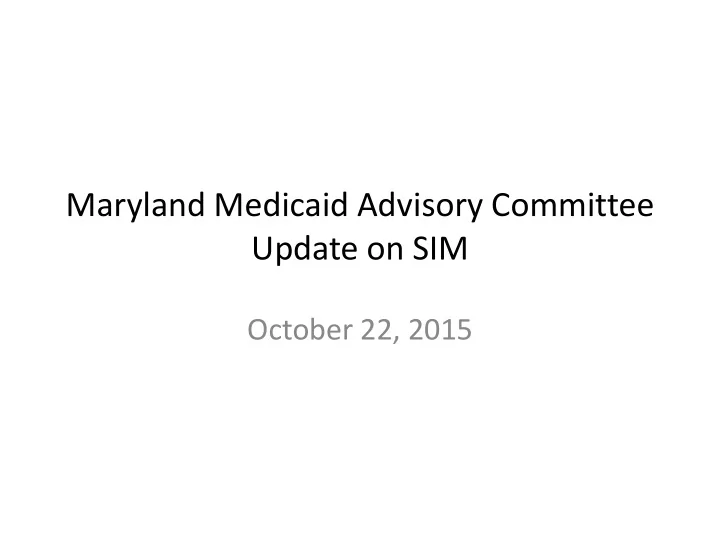

Maryland Medicaid Advisory Committee Update on SIM October 22, 2015
State Transformation Activities • Maryland’s All -Payer Model – Approved by the Center for Medicare and Medicaid Innovation (CMMI) and effective January 1, 2014 – All 46 acute care hospitals are now on global budgets – Hospital spending growth per capita limited to 3.58 percent annually – Required to save Medicare $330 million over five years – Quality components addressing readmissions, hospital-acquired conditions and potentially-avoidable utilization, among others – Year 1 results: Under growth limit, ~$100 million in Medicare savings, positive results in quality programs • Maryland’s State Innovation Model (SIM) Design Award – Approved by CMMI in December 2014 – $2.5 million with a project period though August 2016 – Activities will integrate with and complement the All-Payer Model 2
Maryland’s Current Situation & Future Focus • Year 1 Model results were good: Financial targets were exceeded and quality was improved. • Hospitals are engaging with partners to plan and implement changes to the delivery system. Year 1 Focus Shift to person-centric model Year 2 Focus (Now) Initiate payment reform Work on clinical Years 3-5 Focus (Hospital Global budgets) improvement, care coordination, integration Implement changes, and Focus policies on potentially planning, and infrastructure improve care coordination avoidable utilization that development and chronic care result from care improvements Partner across hospitals, Implement alignment models physicians and other Engage stakeholders providers, post-acute and Develop new models focusing on costs beyond hospitals long-term care, and Build regulatory communities to plan and infrastructure Engage patients, families, and implement changes to care communities delivery Prepare for “Phase 2”, and Alignment planning and focus on total cost of care development and extending the model 3
Maryland’s Alignment Progression Goal: Build clinical integration and supporting financial arrangements over time with the ultimate goal of accountability for Total Cost and Outcomes of Care PHASE 2 2016 Focus PHASE 1.5 Expand 2015 Focus 2017-2018 hospital focus 2019-2024 Focus Hospital to include Focus avoidable partnerships Expand focus utilization with to include and quality physicians, outpatient, programs nursing Total Cost professional centered with homes, and skilled and hospitals behavioral nursing Outcomes health, and opportunities of Care others 4
What is an ICN? A not-for-profit state-wide structure that creates a framework (in concert with government) to help facilitate the engagement of all providers in clinical and financial integration through: – Developing value-based payment templates (with stakeholders) that can be used to help align PCPs, long-term care/post-acute providers, specialists, etc. around care delivery improvement and smarter spending – State-level infrastructure supporting investments of payers and providers Enhanced health information exchange (HIE) data and tools to support care coordination, especially at the point of care (being undertaken by CRISP) – Management tools and support Patient assignment and attribution, building on attribution already in place Opportunity identification Transparent, actionable performance reports – Accountability models Facilitate participation for Medicare providers not enrolled in other ACOs and for Medicaid dual eligibles Plan tools to support accountability models (e.g. outliers, corridors, data collection and reporting, administration, etc.) 5
SIM Design Monies are Supporting Alignment and Transformation • Maryland’s SIM Project will fund the design of the necessary components for dual eligibles to plug into the State’s greater Integrated Care Network and Care Coordination infrastructure. – The State proposed a dual eligible Accountable Care Organization in its SIM application – The contract with EBG Advisors was signed this week to assist us with a dual strategy • The Department’s Public Health Administration is also using SIM monies to develop statewide population health metrics • The contract with Berkeley Research Group was signed this week to assist us with metrics development and projections 6
Stakeholder Process • CMMI has urged HSCRC and DHMH to integrate their stakeholder processes, and stakeholders have urged to HSCRC and DHMH to simplify the process – HSCRC will reconfigure its Advisory Council that was formed when the new All- Payer Model was signed with CMMI; it will include more community and long- term care providers – A stakeholder group will be formed to focus on the ICN – Additional subgroups will be formed, including one to focus on Duals 7
Questions? 8
Recommend
More recommend